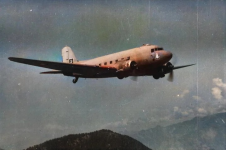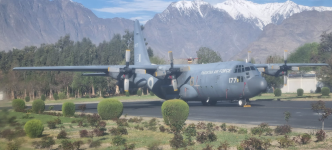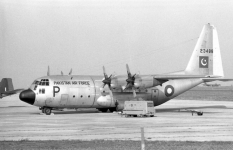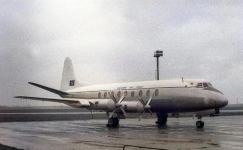Navigation
Install the app
How to install the app on iOS
Follow along with the video below to see how to install our site as a web app on your home screen.
Note: This feature may not be available in some browsers.
More options
Style variation
You are using an out of date browser. It may not display this or other websites correctly.
You should upgrade or use an alternative browser.
You should upgrade or use an alternative browser.
Pakistan Air Force Transport
- Thread starter AZADPAKISTAN2009
- Start date
Foxhound
Member
- Dec 23, 2023
- 2
- 1
Some good points raised as why the transport fleet is not a large ones. However, it would be good to have the extra aircraft to support your missions on a faster pace. For example, once air superiority is gained in a certain sector, then rapid deployments of transport aircraft/paratroopers to aid/consolidate/hold certain key positions (until further reinforcement comes) that can benefit strategically. An example is when the IAF was able to deploy quickly in Srinagar and hold the area before Pakistan forces were able to come, gave India the advantage and hold in that area.Again, there seems to be a misconception that due to many western powers and India having large transport fleets that this is a requirement for Pakistan.
1) We have no foreign or remote territories
2) We have no large number of troops stationed abroad
3) Almost 75% of our forces are within 2 hours drive of Indian border
4) Being a narrow country movement of forces from East to West will be quick
5) For all the country's faults, we have built a great rain and road network (many of us on here will have personal experience of this)
6) Pakistan has no airborne brigade or a airborne assualt strategy
7) In non permissive air scenario, any transport plane, Indian or Pakistani, is dead meat
Now ask yourself why top end air forces like Israel, Japan, Tawain and Turkey have similar number of medium/heavy transports as PAF.? Answer is same, they do not need to travel far to fight their enemy....
Pakistan needs a stronger Transport fleet that can help with their key deployments (especially under the offensive defence doctrine). It needs something similar to the UK's 16 Air Assault Brigade, as follows:
16 Air Assault Brigade Combat Team, known simply as 16 Air Assault Brigade from 1999 – 2021, is a formation of the British Army predominantly based in Colchester, Essex. It makes up the Air Assault Task Force, a battlegroup held at high readiness, and is the only brigade in the British Army focused on operating via parachute, helicopter and air-landing.
As the British Army's rapid response formation, 16 Air Assault Brigade Combat Team has served in the vanguard of all of the Army's recent operational deployments to Sierra Leone, Macedonia, Iraq and Afghanistan, and is the largest brigade in the Army, with 6,200 personnel. It comprises:[4]
- three airborne infantry battalions[10]
- one air assault infantry battalion[10]
- one light recce strike infantry battalion[10]
- one airborne close support artillery regiment[10]
- one close support air manoeuvre engineer regiment[10]
- one air assault logistics regiment[10]
- one air manoeuvre medical regiment[10]
- one Communication and Information Support squadron[10]
- the Pathfinder Platoon[10][11]
The Brigade Headquarters has personnel from both the British Army and the Royal Air Force assigned, enabling it to carry out air and land operations.[4]
Due to the brigade's mobile role, it is lightly armed and equipped.
Foxhound
Member
- Dec 23, 2023
- 2
- 1
It would be great if the PAF were able to negotiate more C130 fleet (Pakistan has decades of experience in maintaining this aircraft), such as the following aircraft retired from the RAF:PAF has enough C-130s ~23 in number for the short to medium term.
14 aircraft
Royal Air Force – 14 aircraft (1 C-130J, and 13 C-130J-30s) were in service as of 2020. The RAF's C-130Js were formally withdrawn from service on 30 June 2023.
Fatman17
THINK TANK: CONSULTANT
- Apr 24, 2007
- 37,451
- 43,829
- Country of Origin

- Country of Residence

At the moment 23 aircraft are in the PAF inventory which seems sufficient for the time being but you are rightIt would be great if the PAF were able to negotiate more C130 fleet (Pakistan has decades of experience in maintaining this aircraft), such as the following aircraft retired from the RAF:
14 aircraft
Royal Air Force – 14 aircraft (1 C-130J, and 13 C-130J-30s) were in service as of 2020. The RAF's C-130Js were formally withdrawn from service on 30 June 2023.
Qureshi
Full Member
- Apr 18, 2011
- 497
- 541
- Country of Origin

- Country of Residence

It would be great if the PAF were able to negotiate more C130 fleet (Pakistan has decades of experience in maintaining this aircraft), such as the following aircraft retired from the RAF:
14 aircraft
Royal Air Force – 14 aircraft (1 C-130J, and 13 C-130J-30s) were in service as of 2020. The RAF's C-130Js were formally withdrawn from service on 30 June 2023.
Bangladesh has already taken 05 of them & its costly option.
Bangladesh receives first of five UK-surplus C-130J transport aircraft
Bangladesh has received the first of five UK-surplus Lockheed Martin C-130J Hercules transport aircraft ordered for the country’s air force.
But there's another option available for PAF (same highlighted in post # 45) if they intend to extend the fleet from 23 (below is the link)
Furthermore, Pakistan can work with KSA to negotiate soft loan terms and can induct as many as required by the PAF.
Some good points raised as why the transport fleet is not a large ones. However, it would be good to have the extra aircraft to support your missions on a faster pace. For example, once air superiority is gained in a certain sector, then rapid deployments of transport aircraft/paratroopers to aid/consolidate/hold certain key positions (until further reinforcement comes) that can benefit strategically. An example is when the IAF was able to deploy quickly in Srinagar and hold the area before Pakistan forces were able to come, gave India the advantage and hold in that area.
Pakistan needs a stronger Transport fleet that can help with their key deployments (especially under the offensive defence doctrine). It needs something similar to the UK's 16 Air Assault Brigade, as follows:
16 Air Assault Brigade Combat Team, known simply as 16 Air Assault Brigade from 1999 – 2021, is a formation of the British Army predominantly based in Colchester, Essex. It makes up the Air Assault Task Force, a battlegroup held at high readiness, and is the only brigade in the British Army focused on operating via parachute, helicopter and air-landing.
As the British Army's rapid response formation, 16 Air Assault Brigade Combat Team has served in the vanguard of all of the Army's recent operational deployments to Sierra Leone, Macedonia, Iraq and Afghanistan, and is the largest brigade in the Army, with 6,200 personnel. It comprises:[4]
The brigade HQ is based in Colchester Garrison and reports directly to Commander Field Army whilst the Army Air Corps units previously assigned to the brigade will remain under Joint Helicopter Command.[12]
- three airborne infantry battalions[10]
- one air assault infantry battalion[10]
- one light recce strike infantry battalion[10]
- one airborne close support artillery regiment[10]
- one close support air manoeuvre engineer regiment[10]
- one air assault logistics regiment[10]
- one air manoeuvre medical regiment[10]
- one Communication and Information Support squadron[10]
- the Pathfinder Platoon[10][11]
The Brigade Headquarters has personnel from both the British Army and the Royal Air Force assigned, enabling it to carry out air and land operations.[4]
Due to the brigade's mobile role, it is lightly armed and equipped.
I see the point you are making here but 16 Air Assault and 3 Commando Brigade are UK assets designed for deployment across the globe and often as part of a coalition (the UK's military losing key capabilities of acting completely alone in many scenarios)
Whilst on paper this looks good, in a Pakistani setting the roles of any air assault brigade will be niche at best. Pak Army doctrine in armoured warfare even assumes it will be under Indian air attack often, so where is the space to fly lumbering transports over contested air space?
A Srinagar like operation may be required but that is a big if, and it is worth keeping such a capability for such a small chance.
Additionally, if you want to deploy anything larger then a battalion you will need to have some heavy lift capability in addition to C-130s.
I think the most likely scenario may well be a tactical operation where we may need a company sized formation or even two companies to deploy quickly to stop a small incursions in harsh terrain (say Rann of Kutch or Kashmir).
US and UK airborne forces have very very rarely performed the traditional airborne role in war. I could be mistaken but apart from a small drop during the invasion of Afghanistan, there has been no major airborne operation during the last 30 off years.
Users who are viewing this thread
Total: 1 (members: 0, guests: 1)
Pakistan Defence Latest
-
-
-
-
-
Khawaja Asif: Afghan Taliban asked for money for the transfer of TTP from the border areas (5 Viewers)
- Latest: alphapak
Country Watch Latest
Latest Posts
-
-
-
-
Hezbollah-Israel Conflict 2024 - Lebanon & Occupied Palestine Territories (79 Viewers)
- Latest: Aziqbal
-











